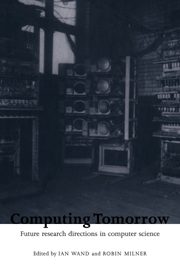Book contents
- Frontmatter
- Contents
- Preface
- Contributors
- 1 The Complexity of Algorithms
- 2 Building Novel Software: the Researcher and the Marketplace
- 3 Prospects for Artificial Intelligence
- 4 Structured Parallel Programming: Theory meets Practice
- 5 Computer Science and Mathematics
- 6 Paradigm Merger in Natural Language Processing
- 7 Large Databases and Knowledge Re-use
- 8 The Global-yet-Personal Information System
- 9 Algebra and Models
- 10 Real-time Computing
- 11 Evaluation of Software Dependability
- 12 Engineering Safety-Critical Systems
- 13 Semantic Ideas in Computing
- 14 Computers and Communications
- 15 Interactive Computing in Tomorrow's Computer Science
- 16 On the Importance of Being the Right Size
- References
- Index
10 - Real-time Computing
Published online by Cambridge University Press: 10 December 2009
- Frontmatter
- Contents
- Preface
- Contributors
- 1 The Complexity of Algorithms
- 2 Building Novel Software: the Researcher and the Marketplace
- 3 Prospects for Artificial Intelligence
- 4 Structured Parallel Programming: Theory meets Practice
- 5 Computer Science and Mathematics
- 6 Paradigm Merger in Natural Language Processing
- 7 Large Databases and Knowledge Re-use
- 8 The Global-yet-Personal Information System
- 9 Algebra and Models
- 10 Real-time Computing
- 11 Evaluation of Software Dependability
- 12 Engineering Safety-Critical Systems
- 13 Semantic Ideas in Computing
- 14 Computers and Communications
- 15 Interactive Computing in Tomorrow's Computer Science
- 16 On the Importance of Being the Right Size
- References
- Index
Summary
Abstract
Real-time computing has been the domain of the practical systems engineer for many decades. It is only comparatively recently that very much attention has been directed to its theoretical study. Using methods originally developed for use in operations research and optimization, scheduling theory has been used to analyse characteristic timing problems in the sharing of resources in real-time computing systems. Independently of this, specification and verification techniques used in sequential and concurrent programming have been extended to allow definition of the timing properties of programs. In terms of effectiveness, the two approaches are still limited and experimental, and neither on its own can yet be used to provide an exact timing analysis or to verify the timing properties of even modestly complex real-time programs of practical size. But if restricted classes of program are considered, they are rapidly approaching the point of practical usefulness. This suggests that the development of a discipline of real-time programming would allow the construction of programs with analyzable and verifiable timing properties. Such a discipline will need to be built upon on a well integrated framework in which different methods are used where appropriate to obtain timing properties to which a high level of assurance can be attached.
Introduction
A real-time computer system interacts with an environment which has time-varying properties and the system must exhibit predictable time-dependent behaviour. Most real-time systems have limited resources (e.g. memory, processors) whose allocation to competing demands must be scheduled in a way that will allow the system to satisfy its timing constraints. Thus one important aspect of the design and analysis of a real-time system is concerned with resource allocation.
- Type
- Chapter
- Information
- Computing TomorrowFuture Research Directions in Computer Science, pp. 188 - 197Publisher: Cambridge University PressPrint publication year: 1996



